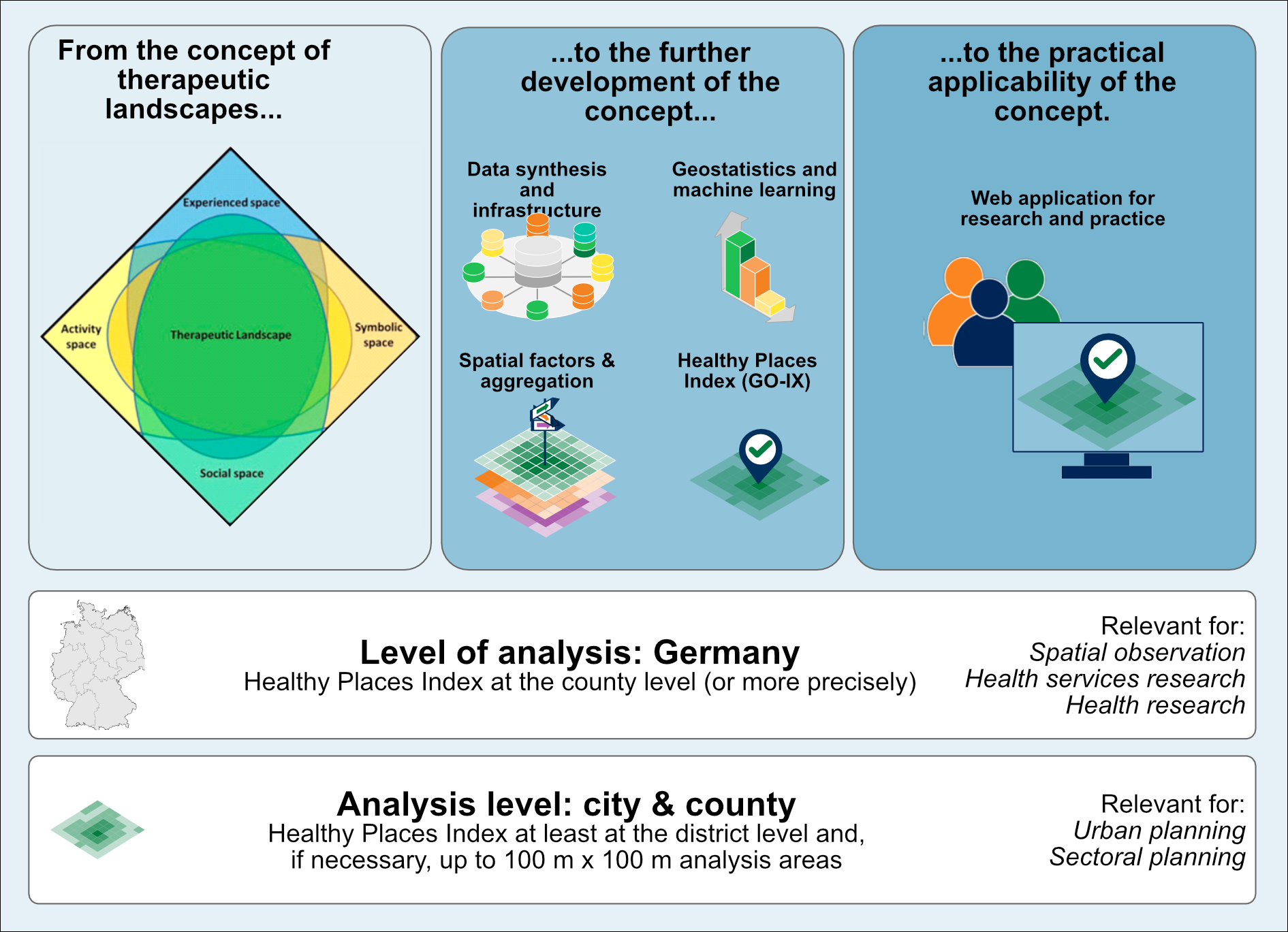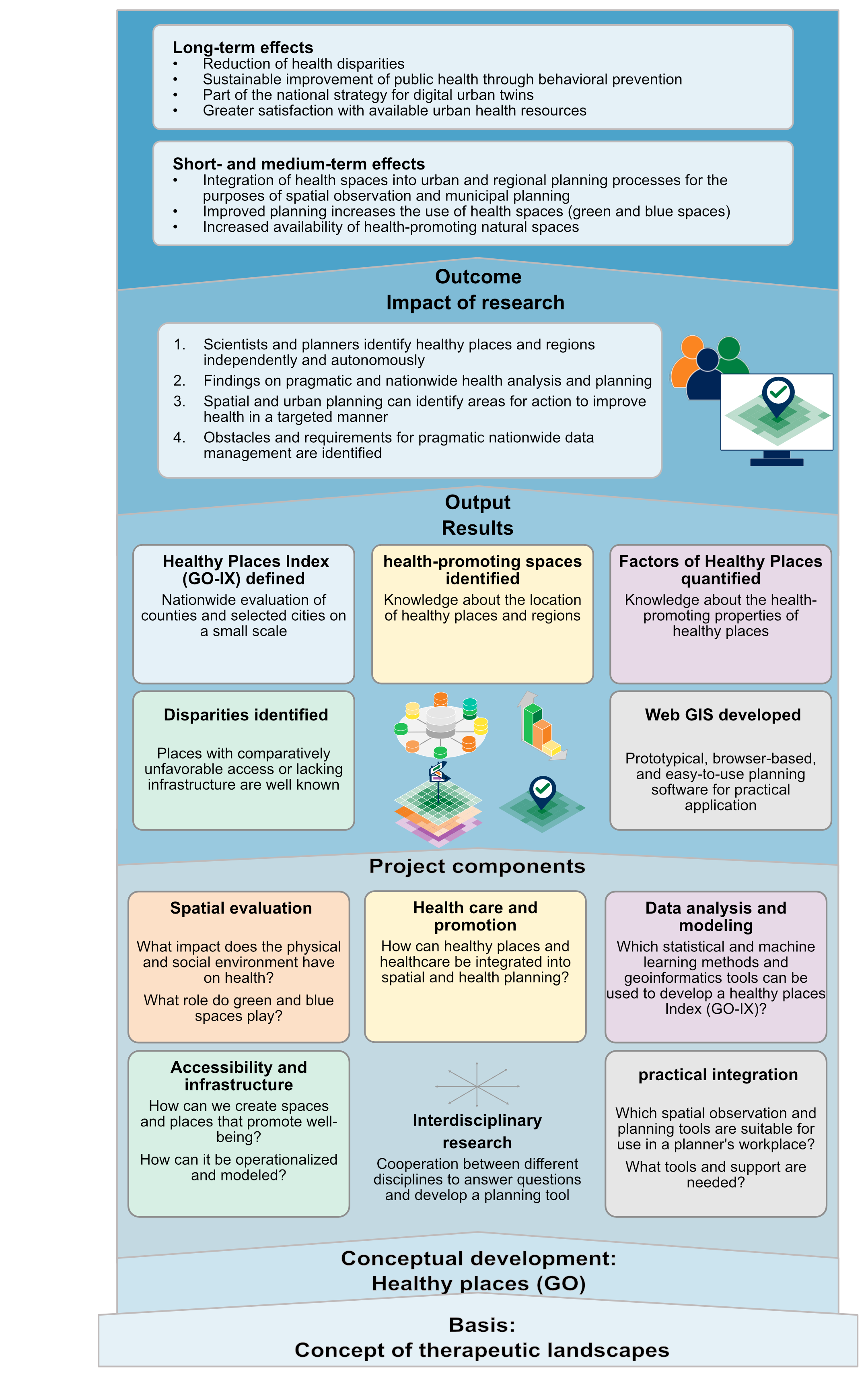# Healthy Places Index (GO-IX)
# Overview
"What keeps people healthy in a place, a city, or a region, and what makes them healthy?" is the central question in our research project GO-IX. GO-IX stands for Gesunde-Orte-Index. This initiative is carried out by an interdisciplinary junior research group consisting of two PhD students and a postdoc. We aim to systematically capture and quantify the diverse spatial factors influencing health and provide them in an easily accessible information tool for planning and policy-making.
This research project is a collaboration between the IU International University (opens new window) and the TU Dresden (opens new window), starting in October 2025, and is funded by the Peter Beate Heller Foundation (opens new window) in the Stifterverband (opens new window).
# Project Goals

Fig: Sketch of the components, results, and impacts of the research project; the figure should be read from bottom to top (translation will follow).
Main goal – Making the concept of therapeutic landscapes practical and applicable for experts: The concept will be developed into a pragmatic form that systematically evaluates and measures public health structures. The research group will collect relevant data and develop a (geo)data infrastructure. This data will be analyzed using established geostatistical methods and modeled through supervised ML techniques. Planners will receive a web application that allows them to identify and analyze healthy places (GO) and make informed decisions based on this analysis. In the background, multi-criteria decision support methods will be applied, and the GO-IX will be integrated for visualization. This tool will be seamlessly integrated into daily workflows, enabling scientists and public authorities to identify, design, and optimize health-promoting spaces.
To achieve this goal, the following sub-goals are an important part of the work program:
Definition of a “Healthy Places Index” (GO-IX): Based on an evaluation at the district level and for selected cities, a nationwide GO-IX will be developed. The index will enable planners and scientists to independently identify healthy places and regions. This will promote the integration of health-promoting features into urban and spatial planning.
Identifying components of health-promoting spaces: Using innovative methods from quantitative statistics, geostatistics, and ML, we will scientifically determine which features and locations define healthy places. This sub-goal will be reached when the research group can quantify and demonstrate which factors characterize healthy places and to what extent different spatial characteristics in human living environments can influence health.
Systematically uncovering disparities in the availability of healthy places: By identifying locations and regions with poor access or insufficient infrastructure, we will better understand health disparities and develop targeted measures to improve accessibility and provision.
Developing planning software for practical use: A web application will enable planners to translate the theoretical concept of therapeutic landscapes into practice. It will serve as a practical planning tool, making it easier to design health-promoting living environments.
# Theoretical Basis
Therapeutic landscapes (TL) play a central role in promoting health and well-being. As everyday places, they support human health through their physical features, emotional connections, and symbolic meanings (Duncan et al., 2009; Gesler, 1992; Hartig et al., 2014; Macintyre et al., 2002; Popay et al., 1998; Williams, 1998).
Improving people’s living environments (conditions) has a strong influence on public health (Barton & Grant, 2012; Frieden, 2010). There is a lack of systematic implementation in practice, especially in urban areas where planning often does not fully leverage the health benefits of landscapes. This makes applying the theoretical foundations of TL in designing healthy places more difficult. Kearns & Milligan (2020) emphasize the need for an interdisciplinary approach combining geoinformatics, spatial epidemiology, and public health to improve understanding and application of TL.
This research project aims to use innovative quantitative approaches to translate theoretical TL concepts into practical tools for health, urban, and spatial planning. This will enable planners and decision-makers to effectively design healthy environments.
The TL concept, originally developed by Gesler (1992) and further elaborated for German medical-geographic research by Claßen & Kistemann (2010), examines the effects of physical places on health and well-being through physical, social, cultural, and emotional experiences. Influenced by the salutogenic approach (Antonovsky, 1979), it focuses on the role of environments and spatial variations in maintaining and promoting health (Kearns & Joseph, 1993), in contrast to the traditional pathogenic model. Völker & Kistemann (2011, 2015) further developed the concept by defining spatial reality and appropriation dimensions to enable a deeper analysis of the complex interactions between landscapes and individual as well as collective health experiences.

Fig: Health Impact Pyramid, extended with the contribution of the research group to translate the theoretical foundations of the therapeutic landscape concept into practice. Own illustration; pyramid adapted from Frieden, 2010.
The figure, based on the Health Impact Pyramid (Frieden, 2010), distinguishes regional or population-based measures according to their impact on the population and the required individual effort. To establish healthy places, the research group focuses on the two most influential levels — socioeconomic environmental factors and changes in circumstances ➀ — since their measures have a strong impact on health with relatively low individual effort required from the population ➁. However, there is still a gap between theory and practice. While the theoretical concept of TL has been well-researched, the development of practical concepts and tools for implementation is still lacking (Kearns & Milligan, 2020). These theories form the basis for this project and are presented alongside the pyramid with the motivation and methodology of the research.
# Roadmap – Our Work Program
Our work program closely follows the methodological approach of the research project, illustrated in the figure below, from the foundation of Therapeutic Landscapes to the development of the GO-IX with its components, research questions, results, and impacts. Starting from the theoretical basis of Therapeutic Landscapes, the diagram should be read from bottom to top.

Fig: Sketch of the components, results, and impacts of the research project; the figure should be read from bottom to top.
# Potential Results
After the 42-month project period, the following innovations are expected:
- Development of a practice-oriented GO-IX.
- Practitioners and planners can identify therapeutic landscapes.
- Insights into health analysis and planning at the national level.
- Improving health through targeted spatial planning.
- Identifying barriers and needs for data management and updating.
- Forward-looking reuse: Digital Urban Twins will become a future standard in planning.
# Schedule and Organization
Project start: October 2025
Duration: 42 months (until March 2029)
Team: 1 postdoc & 2 PhD students
Embedding and environment:
- Part-time or full-time positions between 50% and 100% of regular working hours
- Workplace in Dresden, at one of the IU locations (opens new window) or in a home office; in cooperation with the TU Dresden (opens new window)
- Work with the experts of the Team of the Chair of Geoinformatics (opens new window)
- Part of the Research Center P²D Health
- Courses at the Graduate Academy of TU Dresden
- Research colloquium of PhD students at TU Dresden
# Contact
Project Lead
Prof. Dr. Sebastian Völker
IU International University
✉️ sebastian.voelker@iu.org
Scientific Implementation
M.Sc. Falko Krügel (Postdoc, TU Dresden)
✉️ falko.kruegel@tu-dresden.de